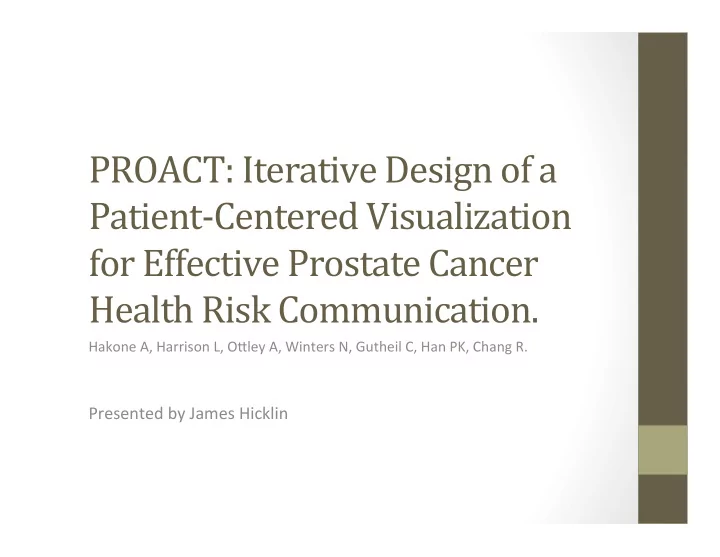

PROACT: Iterative Design of a Patient-Centered Visualization for Effective Prostate Cancer Health Risk Communication. Hakone A, Harrison L, O8ley A, Winters N, Gutheil C, Han PK, Chang R. Presented by James Hicklin
Context: prostate cancer • 80% of cases clinically localized • Two treatment categories • AcJve treatment (surgery, radiaJon) • ConservaJve treatment (watch & wait) • Only 10% of paJents choose conservaJve treatment • Fear of cancer (“death sentence”) • Lack of informaJon
Patient lack of information • ExisJng tools physician-oriented • PaJent numeracy can be problemaJc • CogniJve biases exist h8ps://urology.ucsf.edu/research/cancer/prostate-cancer-risk-assessment-and-the-ucsf-capra-score
System goals • Improve prostate cancer paJent understanding of their individual health risk informaJon • Provide a framework for physicians to guide them in communicaJng risk informaJon
Design process • IteraJve design based off paJent & doctor evaluaJon of prototype • First iteraJon • NarraJve established from consulJng experts • VisualizaJons inspired from review of health risk communicaJon literature • Data sourced from validated clinical predicJon models
Clinical prediction models • Individualized prognosis esJmates based on real evidence • Not widely used • IncompaJble with clinical pracJce • Not paJent-oriented • Two CPMs inform data in PROACT
Iteration #1
Risk of death Hakone et al., IEEE Transac2ons on Visualiza2on and Computer Graphics, 2017
Probability of survival Hakone et al., IEEE Transac2ons on Visualiza2on and Computer Graphics, 2017
Combined probabilities Hakone et al., IEEE Transac2ons on Visualiza2on and Computer Graphics, 2017
Evaluation (iteration #1) • 2 urologists and 6 prostate cancer survivors • HypotheJcal scenarios completed (paJents: 4, urologists: 1) • Decision confidence assessed at 4 points (paJents only)
Findings (iteration #1) • Sequence of narraJve important – “How much 2me do I have leD?” • Difficult to reason without this • Context is criJcal – heightened emoJonal state causes difficulty in processing informaJon • Suggests that first step of tool should calm the paJent down
Findings (iteration #1) • Sliders controlling temporal element were completely ignored • Temporal area chart not understood by 6 out of 8 parJcipants • Perhaps parJcipant demographics not properly considered • “I like numbers, but I’m old so I oDen need 2me to study graphs”
Findings (iteration #1) • ParJcipants confused as colors across visualizaJons were inconsistent, despite data being condiJonally linked
Iteration #2
PROACT demo hKp://tuDsvalt.github.io/proact/demo/pilot2/
Discussion • All paJents recalled lack of informaJon provided by physician, and resorted to searching the internet for informaJon • Study contribuJons: • Allows paJent access and understanding of clinical predicJon models • CommunicaJon guide for consultaJons
Discussion: design guidelines • Account for user’s emoJonal state • NarraJve flow of visualizaJon is criJcal • DisJll complex models into simple visualizaJons • Minimize interacJon • Sacrifices exploraJon • But for general public, this may improve understanding of data • Grounded iteraJve design • EffecJve when used in target user groups
Critique • Pros • Sample representaJve of target user • Converts physician-oriented clinical predicJon models to paJent-oriented risk visualizaJons • Simple visualizaJons so that wide range of target users can understand informaJon
Critique • Cons • IteraJve process feels a li8le contrived – cannot imagine any 80 year old being able to understand the temporal area chart. • Sample size small • No effort made to represent and convey uncertainty • Only accounts for two treatments – other treatments available but not discussed • Only takes survival into account – other a8ributes (side effects, cost, etc.) not considered
References • Hakone, Anzu, Lane Harrison, Alvi8a O8ley, Nathan Winters, Caitlin Gutheil, Paul K. J. Han, and Remco Chang. "PROACT: IteraJve Design of a PaJent-Centered VisualizaJon for EffecJve Prostate Cancer Health Risk CommunicaJon." IEEE TransacJons on VisualizaJon and Computer Graphics 23.1 (2017): 601-10. • Stephenson, Andrew J., Michael W. Ka8an, James A. Eastham, Eric A. Klein, Fernando J. Bianco, Andrew J. Vickers, Ofer Yossepowitch, and Peter T. Scardino. "Prostate Cancer-Specific Mortality Aler Radical Prostatectomy For PaJents Treated In The Prostate- Specific AnJgen Era." The Journal of Urology 179.4 (2008): 649. • Lu-Yao, Grace L. "Outcomes of Localized Prostate Cancer Following ConservaJve Management." Jama 302.11 (2009): 1202.
Thank you! Questions?
Recommend
More recommend